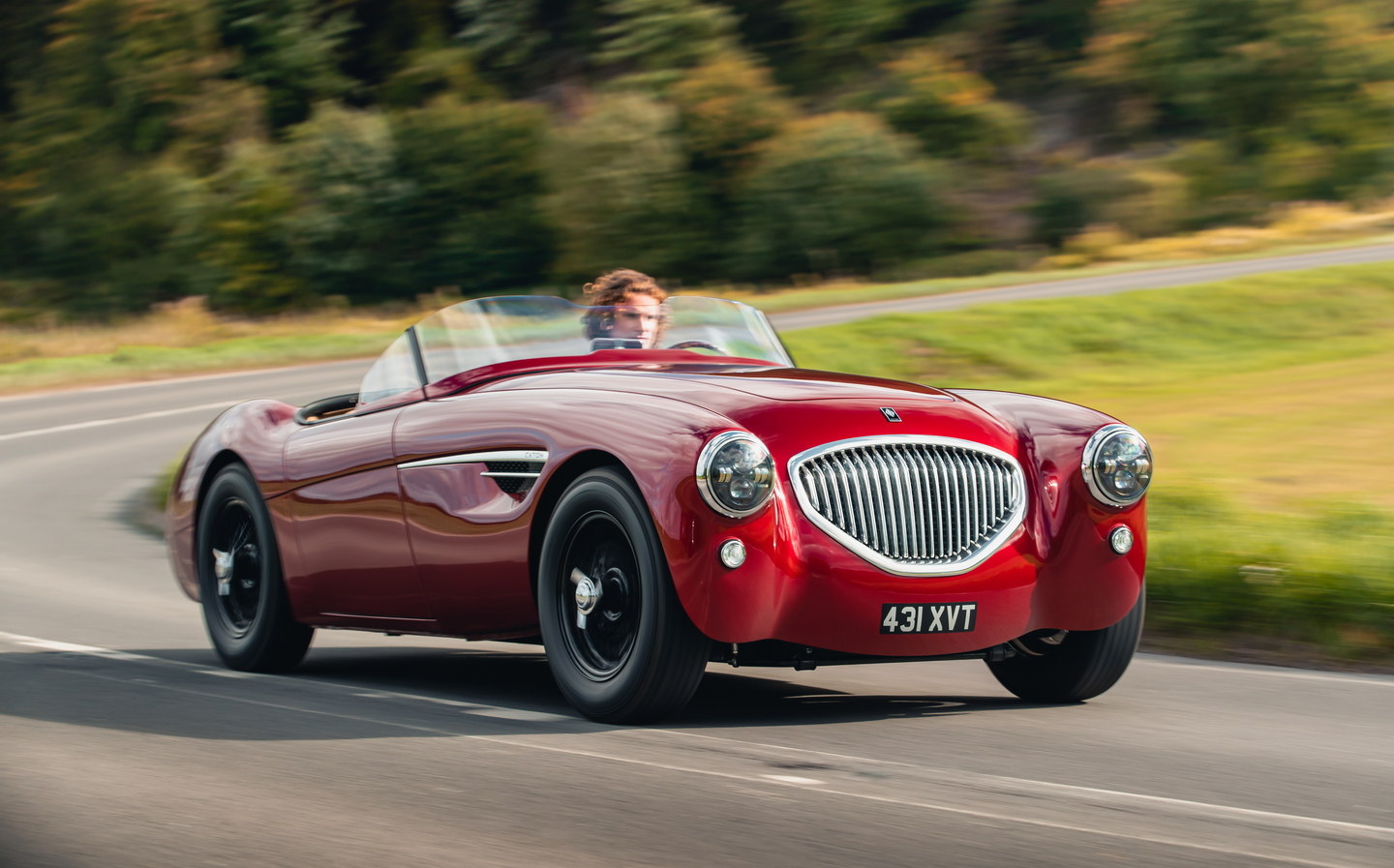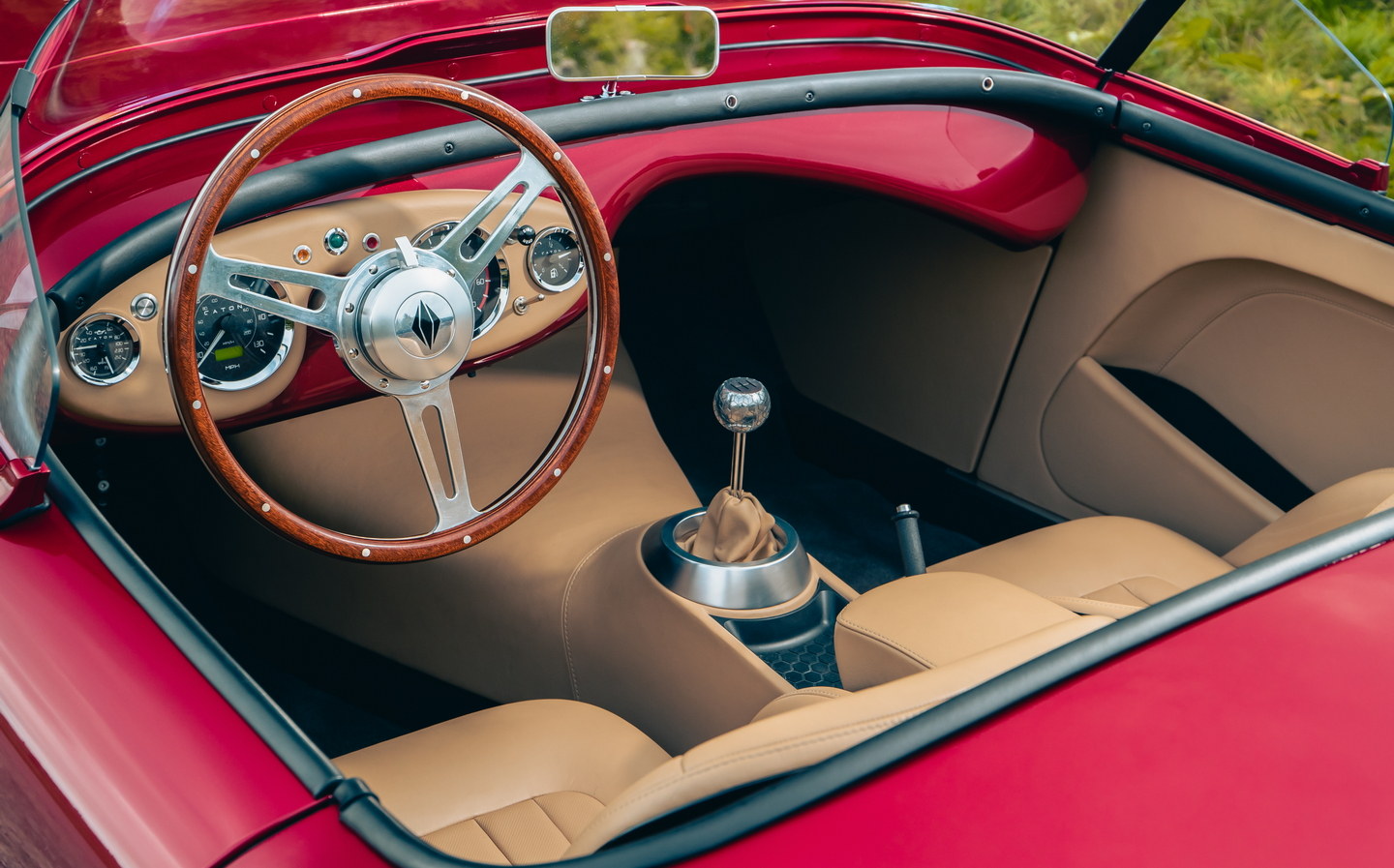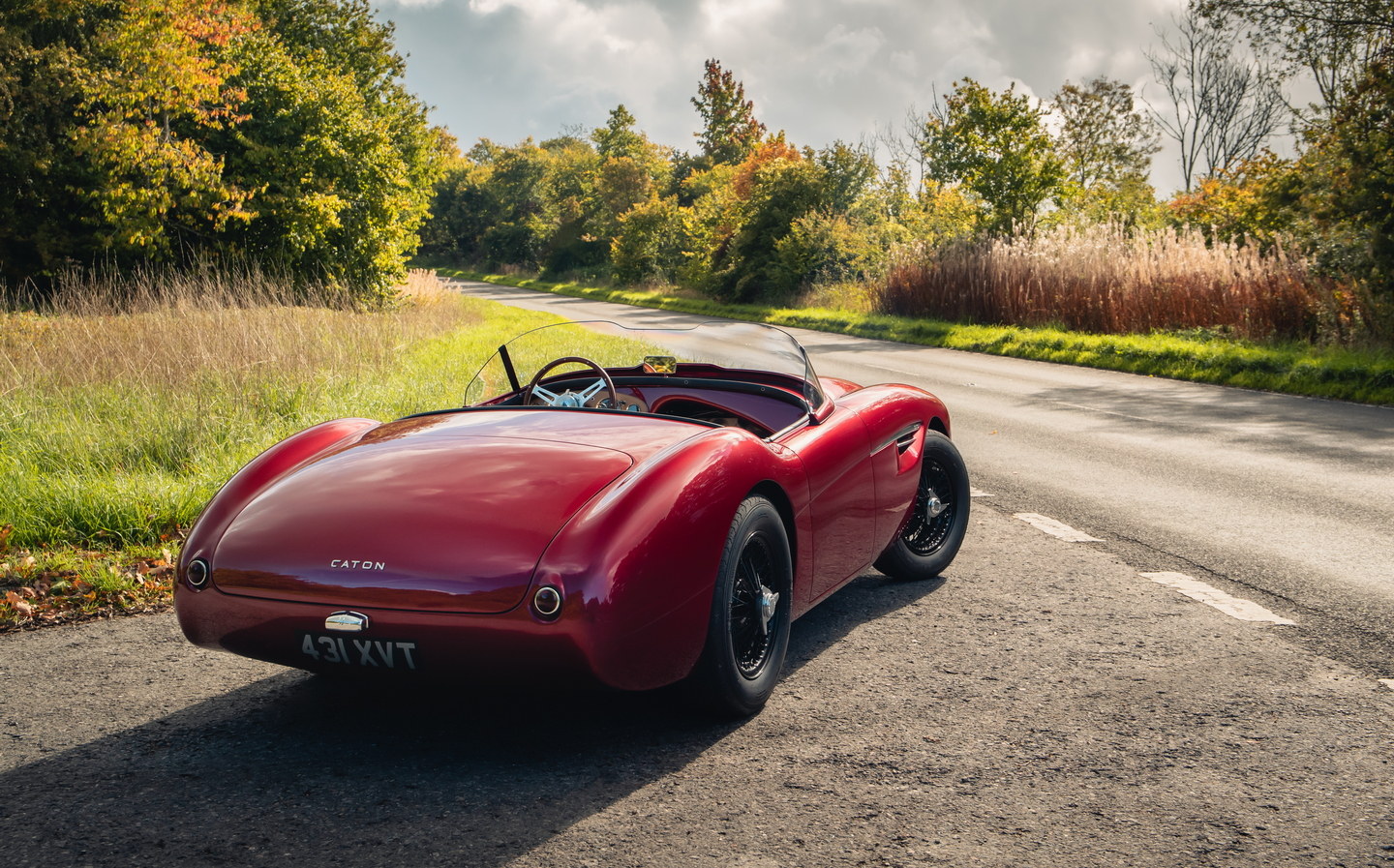Healey by Caton review: Why half-million-pound restomod is a little too authentic in classic car experience
More resto, less mod
The restomod scene – where old cars are updated with modern technology and techniques – is big business in the UK, with countless new versions of classic models hitting the market. Generally speaking, the idea is to make classic car ownership more appealing, either by tweaking the design, improving the powertrain and tuning the handling characteristics. Or, in some cases, it’s simply about making the car work properly.
Working out the rationale behind the Healey by Caton has been somewhat difficult to discern, and that’s not because the company isn’t forthcoming about its intentions.
Despite extensive work, this revamped Healey 100/4 development car has been beset by problems that made it difficult for us to test it. First the clutch bearing went, then there was a problem with the aero screen. Then there was an electrical gremlin and the passenger door wouldn’t close. Then the passenger door wouldn’t open, and then a bolt came loose and all the fuel fell out of the carburettors.
In short, it was exactly like test-driving a bona-fide classic. So how exactly has Caton modified this 1950s sports car?

Exterior design and rivals
Warwickshire-based Caton has taken the original Healey 100/4 shape and 3D scanned it, searching for ways to tidy up the already pretty design. All the external seams have gone, as have the external hinges on the doors. Some of the handles have gone, too, along with the angular windscreen of the donor car.
Instead, the Caton design is tidier and more uniform than before, thanks to all-new panels that fit together better than on the original Healeys.

It’s a cleaner design, and more modern thanks to a handful of neat details such as the LED headlights that illuminate the road ahead properly. The roof has gone, as well, so nobody is likely to take one out if there’s a chance of a shower. And the external handles and door locks have also disappeared, so you won’t even be tempted to leave it outside.
For all the upgrades and improvements, this is a vehicle that still needs to be looked after like a proper classic car.
Admittedly, it does look gorgeous.
Interior and practicality
As with the exterior, Caton has worked hard to make sure the Healey’s interior looks and feels original and modern at the same time.
The wood and leather are trademarks of classic cars but Caton has applied a level of fit and finish that most modern cars can’t achieve. Yes, it’s minimalist – there isn’t all that much going on in there – but the cabin maintains the cleanliness and classic style of the exterior to great effect.

Unlike some restomodders, Caton has resisted the urge to festoon the Healey’s cabin with 21st century technology, so there’s no touchscreen infotainment system inside. But there is a push-button ignition system, and strangely enough for a car that costs almost £500,000, there’s no key, which is excellent news for would-be thieves.
At least there’s a lockable storage box behind the seats that gives owners a slightly safer place to store valuables.
In more positive news, removing the roof has allowed Caton to make the cabin that little bit bigger, so even relatively tall drivers can fit behind the wood-rimmed wheel, which is smaller than that of the original.
Although the transmission tunnel is wide enough to make the pedals offset from the steering wheel, Caton has fitted an adjustable racing pedal box to help ensure driver comfort.
The transmission tunnel itself gets rather warm on the road, which is just as well because Caton has removed the heater. On a cold day, it gets quite bitter behind the wheel, so we’d recommend buyers invest in a good Irvin jacket.

But what the Caton lacks in creature comforts, it makes up for in craftsmanship. Every little piece of trim is beautifully considered, while what switchgear there is feels solid and upmarket. Expense has not been spared when it comes to materials or attention to detail.
Technology and safety
As befits a car of this era (yes, this is still a 1950s car under the skin), safety features include the driver’s eyes, quick wits and a brake pedal. There are no airbags and no seatbelts, so an accident will not be pretty, and there isn’t much driver assistance tech to prevent accidents happening in the first place. There’s no power steering, no anti-lock brakes and no traction control. You’re on your own.

All of which is a bit of a worry in a car with the fuel tank in the boot, leaf springs under the haunches and a punchy 3-litre engine in the front. It isn’t even like it has size on its side, with dimensions that make a Fiat 500 look positively large. But all that can be said of the original car, too, so it isn’t like its owners are missing out.
In fact, the restomod is – in theory at least – better off, because it’s fitted with disc brakes at all four corners. They might not be big brakes but in a car that weighs less than 1,000kg, they don’t have to be. They don’t stop the car particularly quickly but they’re much better than the drums that would have been fitted to the car when it left the factory.

Aside from that, technology is limited. There’s no infotainment system, not even a radio, and there’s no climate control, but the Caton does come with a USB socket so drivers can keep their phone charged up.
Performance, power output and acceleration
Caton has done some work to the Healey’s engine but it’s hardly the most powerful thing on the planet. As before, it’s a four-cylinder, naturally aspirated petrol unit – there’s no turbocharging here – but it has been bored out from 2.6 to 3 litres, giving it a little more power. Even so, 185bhp is hardly earth-shattering.
That said, with a new five-speed manual gearbox, a limited-slip differential and almost no weight to speak of, the Caton still feels fairly effervescent. The engine isn’t free-revving but it feels meaty and muscular enough to allow relatively brisk progress by the standards of a 1950s sports car.

Caton hasn’t published performance figures, but we reckon the sprint to 60mph takes around eight seconds or so, which puts it on a par with the modern Mazda MX-5.
More importantly, it sounds great, with the side-exit exhaust bubbling away by your hip while the engine clatters and bangs at low revs like a classic aeroplane. It smells like one, too. Put it under load, however, and there’s a lovely rasp to the sound that makes you want to wring it out a bit.
Not only are there no performance figures to work with but Caton has also refrained from publishing fuel economy figures. Possibly because they won’t do the eco-credentials much good. Admittedly, our test car’s fuel leak won’t have helped matters but even Caton’s representatives estimate economy in the teens. But then who is buying one of these cars to save the planet?
Ride and handling
Although the Caton may look modernised thanks to its LED headlights and the smooth bodywork, the mechanical components aren’t especially high-tech. That’s not to say Caton hasn’t made changes to the original – the disc brakes are a shining example of that – but most of the engineering was available when the Healey 100/4 was launched.

That means the Caton comes without power steering, so the gorgeous wheel is quite heavy and there’s quite a bit of play around the straight-ahead. And although it gets more direct when you begin to turn more sharply, there still isn’t a great deal of feel. This is a car you guide down the road, rather than placing it with great precision.
Even the ride is very ‘50s, because although there’s a multi-link suspension set-up at the front, the rear springs would still be familiar to Napoleon Boneparte. The leaf springs work but they are a little agricultural, and the Caton feels a bit stiff as a result.
That said, it’s light enough to get away with it, so although the ride isn’t especially smooth, it isn’t jagged or craggy either. It’s tolerable, especially if you’re just out for a Sunday morning blast.

Which is exactly what the Caton is for. With so little power and old tech, it’s hardly a car for track days, even though it does have a limited-slip differential to help you get the power down. Instead, it’s a very easy car to drive on the road, with great visibility, tiny dimensions and a slick gearbox.
It isn’t precise, but it still feels very happy zipping around the English countryside, eliciting smiles and waves from passers-by as it goes.
Pricing and on-sale date
Getting behind the wheel of a Healey by Caton doesn’t come cheap. At £474,000, it’s an expensive old thing, even if that figure does include a donor car and the VAT.
You can, if you so wish, order one right now, but only 25 will be made available. We suspect they’ll sell out – these things usually do – but even with such exclusivity, we’d find it tricky to call the Healey good value. Particularly when concours-standard original examples sell for well under £100,000.

Verdict: Healey by Caton review
The Healey by Caton can be great fun and it is unquestionably a beautiful thing inside and out, but the extortionate pricetag means it’s difficult to recommend.
What’s more, reliability issues with the development car we tested give us cause to question the engineering, and leave us wondering whether a little more modification might have been in order.
Of course, Caton ought to iron out the problems before customers take delivery but it isn’t a good look for a car that’s barely more exciting than any other cool classic, yet quite a lot more expensive.
Related articles
- After reading our review of the Healey by Caton, you may like to check out this list of things to know before you buy your first EV
- You might also be interested in our roundup of five of the best city cars
- Visit Driving.co.uk’s car clinic here
Latest articles
- Should I buy a diesel car in 2025?
- F1 2025 calendar and race reports: The new Formula One season as it happens
- Zeekr 7X AWD 2025 review: A fast, spacious and high tech premium SUV — but someone call the chassis chief
- Denza Z9GT 2025 review: Flawed but sleek 1,062bhp shooting brake from BYD’s luxury arm
- Extended test: 2024 Renault Scenic E-Tech review
- Best-selling cars 2025: The UK’s ten most popular models of the year so far
- Audi A6 Avant 2025 review: Trusty executive estate ticks expected boxes, and there’s still a diesel option
- Keir Starmer eases pressure on carmakers to sell EVs in response to ‘global economic headwinds’
- Ferrari 12Cilindri Spider review: Heady blend of traditional and futuristic becomes even more intoxicating after lid is removed











































